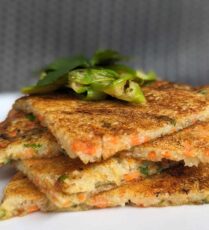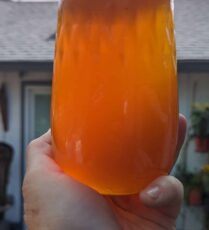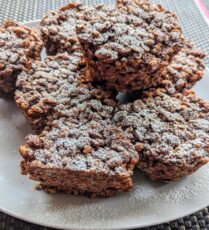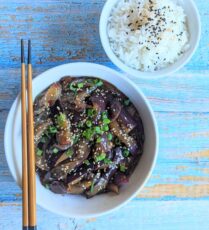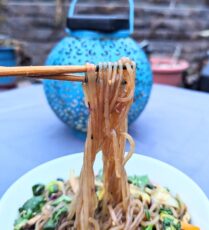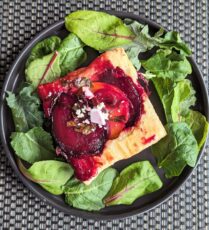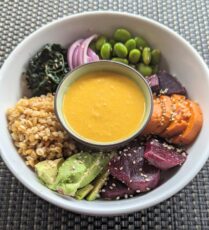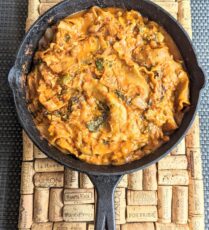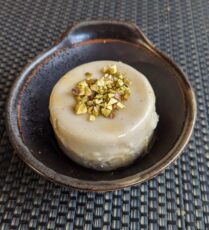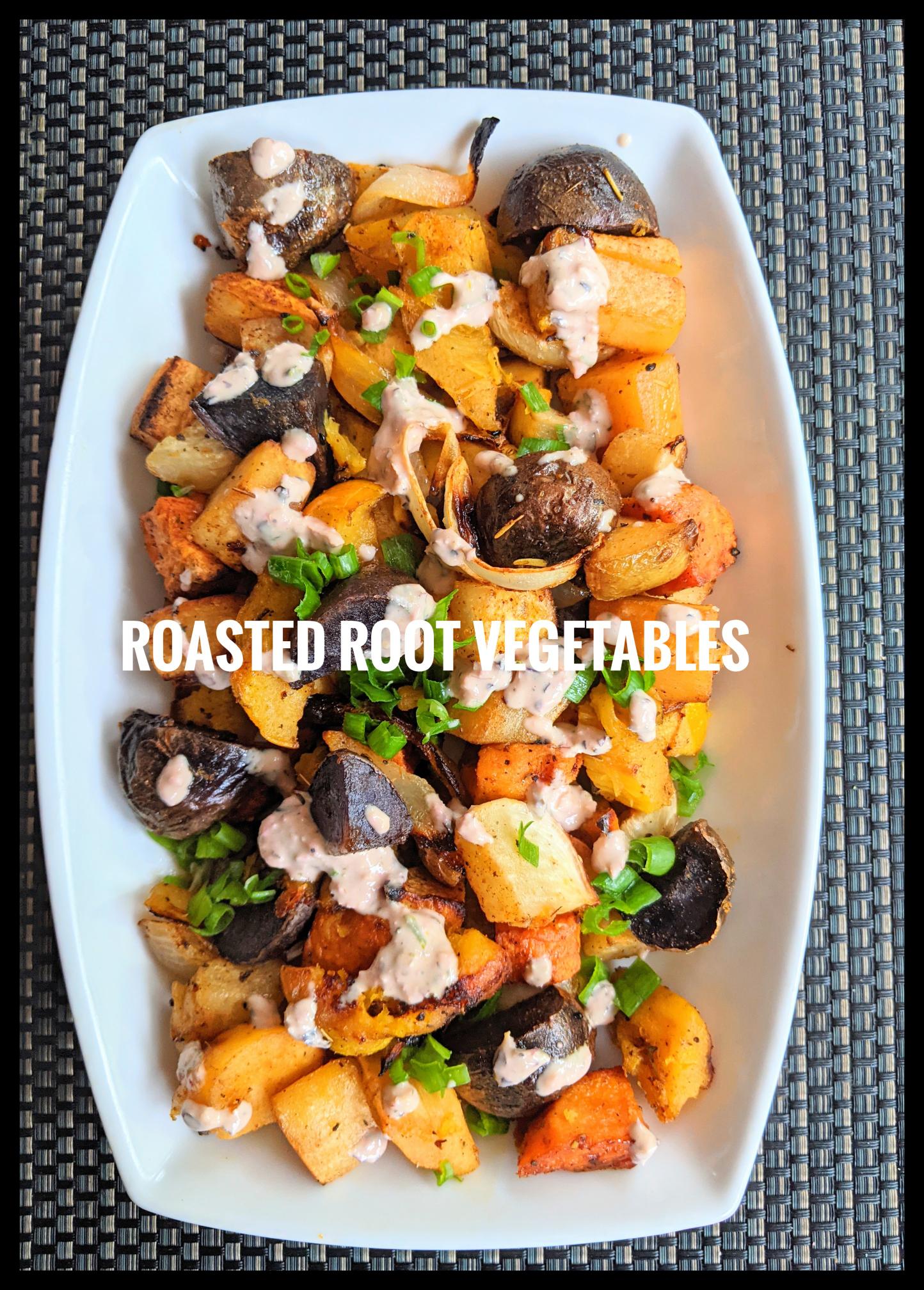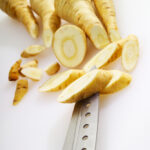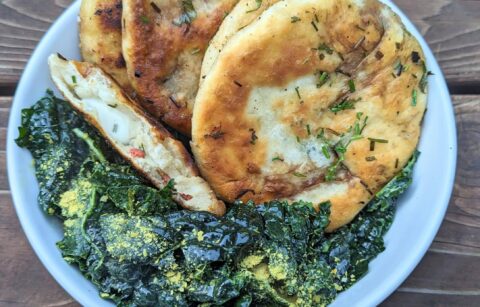Growing up in France, I remember hearing countless stories about World War II. Some of them were about food shortages during these hard times, and how when things were really bad, people survived on boiled turnips and rutabaga! Maybe that’s why I don’t remember ever eating them during my childhood! It was only a few years ago that I explored the world of less common root vegetables like parsnips, turnips, rutabaga, taro, and a few others. It is my opinion that these humble vegetables do deserve a second look and a place on our table! You can mash them, pickle them, roast them, steam them!
If you wonder what they look like, imagine a large radish. White inside and on the bottom with purple on top. The root and the leaves (also called turnip greens) are edible. They can be made into fries, coleslaw, stir-fry, or shredded in salads.
Health Benefits of Turnips
Part root and cruciferous vegetable, turnips are good for the immune system because they supply vitamin C, B6, folate, calcium, potassium, copper, and manganese. Not bad for a large-looking radish!
Fun fact: it was a favorite weapon during Roman times to throw at unpopular public figures!
Parsnips are a cross between carrots and parsley. I often wonder how this came about! They become sweeter when roasted just like carrots do.
Fun fact: parsnips were used as a source of sugar in Europe before cane and beet sugars were available.
You may want to try this simple but delicious cream of parsnip soup recipe.
Are parsnips good for you?
Yes, they are high fiber, in potassium, vitamin C and B6/Folate. They also have anti-inflammatory and anti-fungal properties.
It is a member of the mustard family and a cousin of the turnip! Actually, a rutabaga is a cross between a turnip and a cabbage. Also known as yellow turnip, Canadian or Swede’s turnip.
It is often mashed (think shepherd’s pie), baked, or roasted. It makes a great addition to soups, salads, and noodles. Removing the skin is recommended because of the coat of wax that is used to prevent them from drying. Rutabaga is a little sweeter than turnips. Make sure to pick firm ones no soft ones. Avoid bruised or blemished rutabagas, and if green shoots are coming out of it.
Health Benefits of Rutabaga
Rich in carotenoids and vitamins C and E, rutabaga is a great source of antioxidants.
If you are watching your weight or are on a keto diet, you will be happy to know that compared to potatoes, rutabaga is lower in calories and carbs.
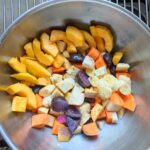
 Now that we covered why these roots vegetables are worthy of our consideration, you only need to roast them with your favorite herbs. This will take 40-50 minutes, which is plenty of time to prepare the pesto tahini sauce that you will drizzle on top.
Now that we covered why these roots vegetables are worthy of our consideration, you only need to roast them with your favorite herbs. This will take 40-50 minutes, which is plenty of time to prepare the pesto tahini sauce that you will drizzle on top.
Make extra because it will taste even better the next day, you can also freeze the roasted vegetables for another time.
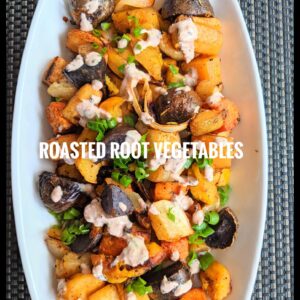
Roasted Root Vegetables with Pesto Tahini Dressing
Equipment
- Lines baking sheet
- food processor
Ingredients
Root vegetables
- 3 turnips cubed
- 2 rutabaga peeled and cubed
- 3 parsnips cut in chunks
- 2 blue potatoes quartered
- 1 large sweet potato cubed
- 1 large onion sliced
- 1 Tbsp olive oil
- 1 tbsp garlic powder
- 2 tbsp rosemary
- 1 tbsp paprika
- salt & pepper
Tahini Pesto Sauce
- 1/2 cup fresh basil
- 1/2 cup fresh mint
- 2 cloves garlic
- 1/4 cup raw walnuts or cashew nuts
- 1 grated lemon rind
- 1/2 lemon juice
- 2 tbsp sesame butter (tahini)
- 1/4 cup warm water
- 1 tsp maple syrup
- sea salt & black pepper
Instructions
Prepare vegetables
- Preheat the oven to 400 F
- Cut the turnips, parsnips, and purple potatoes into medium chunks.
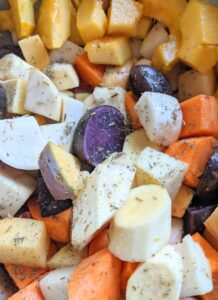
- Peel and cube the rutabaga and sweet potatoes.
- Slice the large onion.
- In a large bowl or a large zip-lock bag, combine the olive oil with the garlic powder, sweet or smoked paprika, rosemary, sage, salt, and pepper.
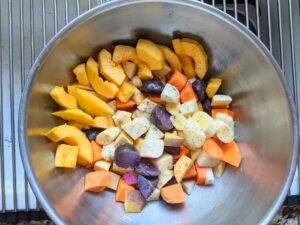
- Add the cut root vegetables and onion. Seal and mix until every piece is coated.
- Line a baking sheet with either parchment paper or a silicone mat.
- Pour the content of the bag and make sure that no chunk overlaps. You may need 2 trays.
- Bake at 400 F for 25 minutes.
- Flip every piece and bake for another 20 minutes.
- Let it cool down a few minutes before serving and adding the sauce.
Tahini Pesto Sauce
- Add the fresh basil, mint, garlic, nuts, lemon rind to a food processor and pulse a few times to break down the nuts and fresh herbs
- Mix the tahini, with lemon juice, maple syrup, water, and stir until everything is blended.
- Slowly drizzle the tahini liquid and process until you have a creamy consistency.
- Add salt and pepper and taste.
Notes


